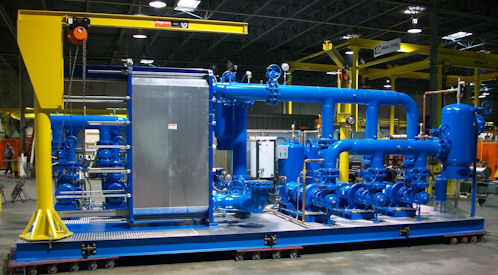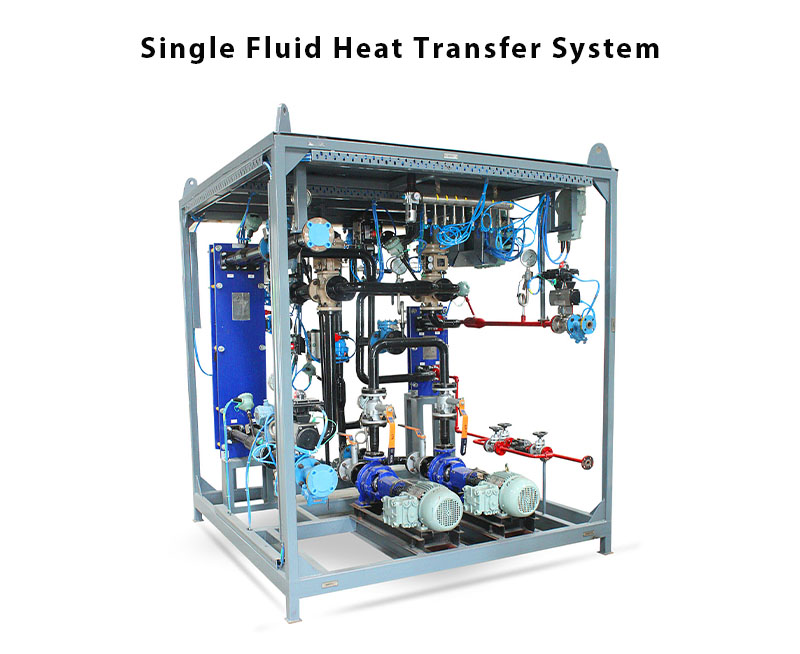A Comprehensive Overview to Choosing the Right Heat Transfer Equipments for Your Needs
Selecting the proper Heat transfer system is necessary for operational efficiency. Various systems satisfy different needs, influenced by elements such as temperature variety and liquid kind. Recognizing the principles behind Heat transfer, such as convection, conduction, and radiation, is crucial. In addition, reviewing energy sources and upkeep practices can impact long-term performance. A closer examination of these factors to consider exposes exactly how to tailor a system to certain demands. What should one prioritize in this facility decision-making process?
Recognizing Heat Transfer: Key Principles and Principles
Although Heat transfer might seem like an uncomplicated concept, it encompasses a variety of principles that are essential for reliable system design. Understanding these principles is essential for engineers and developers who aim to optimize thermal performance in various applications. Conduction, for instance, entails the transfer of Heat through solid products, while convection describes the motion of Heat within fluids. Radiation, an additional key principle, describes exactly how Heat can be transferred through electro-magnetic waves. Each of these devices plays a crucial function in identifying how energy relocates within a system. By thoroughly comprehending these ideas, experts can make informed decisions, making sure that Heat transfer systems operate successfully and fulfill the particular demands of their applications
Kinds Of Heat Transfer Solutions: An Overview
Comprehending the concepts of Heat transfer prepares for discovering the different types of Heat transfer systems readily available. Heat transfer systems can be categorized largely right into three kinds: conduction, convection, and radiation. Conduction involves Heat transfer through solid products, counting on direct contact in between fragments. Convection, on the other hand, occurs in liquids (liquids and gases) where the movement of the liquid itself helps with Heat transfer. Radiation includes the transfer of Heat through electro-magnetic waves and does not call for a medium, enabling it to take place in a vacuum. Each kind of system has distinctive qualities and applications, making it essential for people and organizations to thoroughly evaluate their specific needs when picking the most suitable Heat transfer option.
Applications of Heat Transfer Solutions in Different Industries
Heat transfer systems play a vital role across different sectors, impacting performance and item quality. In commercial production procedures, they promote precise temperature control, while in food and drink handling, they assure security and preservation. Additionally, cooling and heating and climate control systems rely greatly on effective Heat transfer to keep comfortable settings.
Industrial Manufacturing Processes

Numerous commercial manufacturing processes rely greatly on efficient Heat transfer systems to make best use of performance and boost product high quality. In markets such as metalworking, Heat exchangers play a vital duty in maintaining suitable temperatures throughout welding, casting, and creating. These systems guarantee uniform Heat circulation, which is essential for attaining wanted product buildings. In the chemical production industry, Heat transfer systems help with precise temperature level control throughout responses, influencing yield and safety and security. Moreover, in fabric manufacturing, reliable Heat administration is essential for dyeing and ending up processes, influencing color consistency and fabric quality. By picking ideal Heat transfer innovations, manufacturers can improve power performance and reduce functional prices, inevitably resulting in a more affordable and sustainable manufacturing atmosphere.
Food and Drink Handling
Efficient Heat transfer systems are equally essential in the food and beverage handling market, where keeping perfect temperatures is essential for food safety and top quality. These systems play an important function in procedures such as sanitation, food preparation, and pasteurization, guaranteeing that products are secure for consumption and keep their nutritional worth. Heat exchangers, as an example, successfully transfer Heat between fluids, optimizing energy usage while lessening temperature variations. Furthermore, refrigeration systems are essential for protecting subject to spoiling items and prolonging rack life. The selection of Heat transfer modern technology straight influences functional effectiveness and product honesty, making it imperative for food and drink manufacturers to select the appropriate systems customized to their specific handling needs. This mindful option ultimately adds to consumer complete satisfaction and food safety.

A/c and Climate Control
While many industries rely upon Heat transfer systems for efficiency, HVAC (Heating, Ventilation, and A/c) plays a necessary role in preserving indoor environment control across various setups. These systems use Heat transfer principles to regulate temperature level, moisture, and air high quality, guaranteeing comfort and safety in residential, business, and commercial environments. Appropriately designed a/c systems improve energy performance, decrease operational prices, and lessen ecological impact. In business structures, for instance, efficient environment control adds to employee productivity and client satisfaction. In industrial applications, cooling and heating systems help preserve suitable conditions for devices procedure and item conservation. Selecting the best Heat transfer system is important for meeting internet details environment control requirements and accomplishing general system performance.
Reviewing Power Sources for Heat Transfer Equipments
In evaluating power sources for Heat transfer systems, a comparison of renewable resource alternatives and nonrenewable fuel source considerations is vital. Sustainable sources, such as solar and wind, offer lasting options that can decrease environmental influence. On the other hand, nonrenewable fuel sources remain widespread due to their recognized facilities and power density, prompting a mindful evaluation of both options.
Renewable Resource Options

Nonrenewable Fuel Source Factors To Consider
Examining fossil fuel factors to consider is necessary for the efficiency and sustainability of Heat transfer systems. Fossil gas, such as gas, oil, and coal, are standard power resources that supply significant Heat result, making them popular options for industrial and property applications. Their ecological effect, including greenhouse gas exhausts and resource exhaustion, increases issues. When picking a heat transfer system, it is important to analyze the accessibility, cost, and governing factors connected with these gas. Additionally, the efficiency of nonrenewable fuel source systems need to be taken into consideration, as higher efficiency can mitigate some ecological disadvantages. Inevitably, a well balanced method evaluating efficiency and sustainability can lead decision-makers towards one of the most ideal Heat sites transfer service for their certain demands.
Factors to Take Into Consideration When Selecting a Warm Transfer System
Choosing an appropriate Heat transfer system requires mindful factor to consider of various variables that can significantly affect performance and efficiency. One vital aspect is the operating temperature range, which determines the products and layout suitable for the application. Additionally, the kind of liquid made use of in the system-- whether gas or liquid-- impacts Heat transfer effectiveness and compatibility. The system's dimension and capability have to straighten with the particular requirements of the procedure to avoid ineffectiveness. Energy resource schedule is likewise vital, affecting operating expense and sustainability. In addition, the installment atmosphere, including area constraints and ease of access for maintenance, plays a significant duty in system choice. Ultimately, governing compliance and security criteria have to be thought about to assure the system satisfies all lawful demands.
Maintenance and Effectiveness Optimization for Heat Transfer Solutions
Maintaining Heat transfer systems is necessary for guaranteeing optimal effectiveness and longevity. Routine maintenance tasks, such as cleansing Heat exchangers and evaluating insulation, aid avoid performance losses due to fouling and thermal linking. Additionally, keeping track of system specifications, consisting of pressure and temperature level, enables for very early detection of abnormalities, minimizing downtime and expensive repairs. Executing a preventive maintenance routine can maximize efficiency and extend the life expectancy of components. Upgrading to innovative control systems can enhance operational performance by readjusting to differing conditions and lots. By focusing on upkeep and performance optimization, drivers can accomplish minimized energy consumption, reduced operational prices, and improved general system dependability, eventually bring about better resource utilization and a more sustainable procedure.
Future Trends in Heat Transfer Technologies
As sectors increasingly prioritize sustainability and power performance, future fads in Heat transfer modern technologies are readied to undergo considerable makeovers. Innovations such as innovative products, consisting of carbon nanotubes and nanofluids, promise enhanced thermal conductivity and performance. Additionally, the integration of eco-friendly energy resources right into Heat transfer systems is gaining momentum, advertising environmentally friendly options. Smart modern technologies, including IoT sensors, are expected to have a peek at this website transform surveillance and control, making it possible for real-time data analysis for enhanced performance. Furthermore, the growth of portable and modular systems will help with much easier installment and maintenance, catering to diverse applications. These advancements indicate a change towards more lasting, efficient, and adaptable Heat transfer options, aligning with international energy goals and ecological standards.
Regularly Asked Questions
What Are the Ecological Influences of Heat Transfer Equipments?
The environmental influences of Heat transfer systems can consist of greenhouse gas discharges, energy consumption, and prospective thermal air pollution. Additionally, inappropriate disposal of materials and inadequacies can add to resource exhaustion and environment interruption.
How Do I Calculate the Cost-Effectiveness of a Heat Transfer System?
To calculate the cost-effectiveness of a warm transfer system, one have to evaluate initial prices, functional expenditures, maintenance needs, and power effectiveness, contrasting these factors against the expected life expectancy and efficiency of the system.
Can Heat Transfer Systems Be Made Use Of in Residential Setups?
Heat transfer systems can certainly be used in residential setups. They supply effective home heating and cooling solutions, making homes more comfy while possibly lowering power costs. Their convenience permits different applications in property environments.
What Safety Regulations Apply to Heat Transfer Solutions?
Safety guidelines for Heat transfer systems generally consist of guidelines on procedure, maintenance, and installation. Compliance with regional structure codes, manufacturer specs, and sector criteria is important to assure effective and risk-free system efficiency in numerous applications.
Exactly How Do Different Products Affect Heat Transfer Efficiency?

Transmission, for instance, entails the transfer of Heat with solid materials, while convection refers to the motion of Heat within fluids. Understanding the concepts of Heat transfer lays the groundwork for discovering the numerous kinds of Heat transfer systems available. Heat exchangers, for instance, effectively move Heat in between liquids, maximizing power usage while decreasing temperature level variations. In examining power sources for Heat transfer systems, a contrast of eco-friendly power choices and fossil fuel considerations is essential. Metals, such as copper and aluminum, conduct Heat properly, whereas insulators like rubber and glass slow down Heat flow.